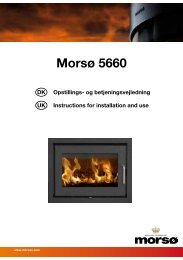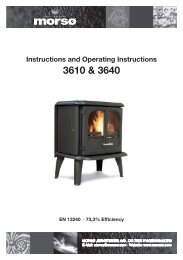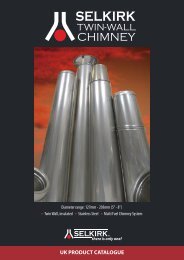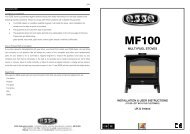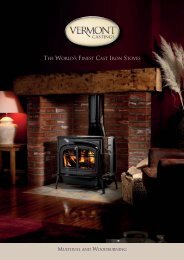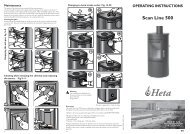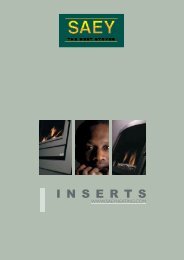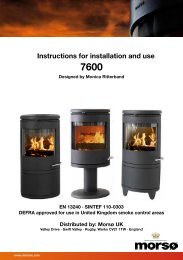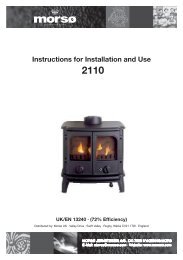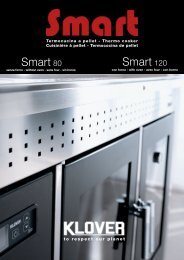Create successful ePaper yourself
Turn your PDF publications into a flip-book with our unique Google optimized e-Paper software.
Hearth requirements:The stove MUST be fitted in accordance with Local and National Building Regulations.The O-serie stoves has been independently certified.During the safety test the floor temperature did not exceed 100°C. The stoves may therefor beplaced onto a hearth made of non-combustible board/sheet material or tiles at least 12 mm. thick.Consideration should also be given as to the stove weight to ensure thatthe underlying floor is able to bear the weightThe handle will get hot when the stove is in use, for this reason a safety mitten is provided.1.5 The chimneyOnly if National or Local Regulations permit are you permitted to connect a stove into a chimneythat is shared by another appliance. YOU MUST be aware of any applicable Regulationsin this respect.The wood-burning stove must never been connected to a chimney to which a gas-burning stoveor appliance is connected.An efficient modern stove places heavy demands on the chimney, and you should have thechimney regularly swept and inspected by your approved chimney sweep.The cross-sectional area of the chimney (at its narrowest point) must comply with National andLocal Building Regulations. Generally, the area needed for an <strong>Ø</strong>-<strong>Collection</strong> wood-burning stoveinstallation should measure at least 175 cm2 (150 mm diameter).An over-sized chimney is generally hard to keep warm and results in poor draft. In cases wherethere is an oversized masonry chimney, it is recommended that the chimney be lined using anappropriately chimney lining system with the correct internal diameter.With respect to the chimney termination, all chimneys should terminate in accordance withNational and Local Building Regulations.Note that National and Local Regulations also apply with regard to the placement of chimneysand flues in connection with thatched roofs. See the section on Draft Conditions, 1.9.The chimney or flue system must be equipped with access doors for inspection and cleaningdoors. The size of the cleaning door in the chimney must at least equal that of the cross-sectionalarea of the chimney.1.6 Pipe ConnectionYour stove is supplied ready for a top flue connection (4). Therear flue outlet is fitted with a cover plate and is situated on theback panel. Where a rear flue installation is required, unbolt theflue collar. Unbolt the cover plate and install it onto the top ofthe stove. The flue collar can then be bolted over the rear flueoutlet using the bolts and clamps provided.Make sure that the baffles (2 and 3), the firebricks,and the riddling grate are positioned correctly.Placement of draft reducer (only <strong>Ø</strong>4)The <strong>Ø</strong>4 is supplied with a fitted draft reducer(1) as shown in the diagram.Where a rear flue exit (3) is required, the draftreducer is not to be used.5
1.7 Connecting the stove to a masonry chimneyA wall sleeve should be bricked securely into the wall of the chimney at the appropriate heightand the stovepipe inserted centrally. The pipe must not extend into the actual chimney opening,but rather must reach only to the inside of the chimney aperture. The gap between the stovepipeand sleeve must be sealed using glass fibre packing rope.Only use stovepipe components that comply to National and Local Building Regulations.1.8 Connecting to a stainless steel insulated chimney systemIf your installation involves taking the chimney straight up and through the ceiling, you mustcomply with National, Local Building Regulations or flue manufacturers instructions concerningclearances to combustible materials such as walls, floor joists and ceilings. The joint betweenthe stove flue collar and the stovepipe must also be sealed using the glass fibre rope provided.It is important that the insulated flue system is properly supported both at ceiling level andat roof level. THE STOVE MUST NOT BEAR THE WEIGHT OF THE CHIMNEY SYSTEM (Seechimney manufacturer’s instructions). Excessive weight on the stove will inhibit expansion andcould lead to damage of the stove top. Damage caused to the stove in this way would not becovered by the manufacturers guarantee.In the event that a chimney fire occurs as a result of faulty operation or prolonged use ofdamp wood fuel, close the air vents completely and contact your local fire departmentimmediately.Be aware of the following:Cleaning procedure: Discuss this with chimney sweep or qualified installer priorto or during the stove installationChimney draft: If the chimney draft is naturally poor it is better to install the fluefrom the top of the stove so as to minimise any internal resistance of the fluegases.Avoid having any more than 2 bends in the flue system and limit the length of theoffset between bends.Fresh air supplyA wood-burning stove requires air for combustion and therefore you may need toinstall additional ventilation to the room, especially so in well insulated houses.If the air supply in inadequate the chimney draft may be too weak, with the possibleresult that the stove will not burn properly; smoke spillage may also occurduring the refuelling process.On a positive note, a properly installed wood-burner will give even the most efficienthouses a pleasant and natural ventilation.67
1.9 Draft conditionsIf smoke spillage occurs when the fire door is opened, it is probably due to poor chimney draft.This type of stove requires at least 12 pa of chimney draft to achieve satisfactory combustionand smoke spillage prevention. However, in cases where the stove door is opened too vigorouslyyou could expect that slight smoke spillage may occur.If there is too much draft from the chimney, a damper device can be installed in the chimneyto reduce the draft.Please note that this damper device must not close the aperture area in the chimney entirely.There must be a clear opening of at least 20 cm2 when the damper is closed.If you have any doubts, you may want to have your installer measure the draft in the chimney.Stove Type The Flue Gas Temperature at the The Flue Gas Flow is (gr/sec.)rated output is (°C) relative to 20° C<strong>Ø</strong>4 270 4,1<strong>Ø</strong>6 300 7,6<strong>Ø</strong>8 353 8,7Draft conditionsThe chimney’s draft is the resulting effect within the flue caused by the difference intemperature within the flue and the cooler temperature outside. Other factors thatcan influence the level of draft include the length of the flue, insulation of the chimney,adverse weather conditions or tall buildings or trees nearby the flue terminal.Poor draft occurs when:• The atmospheric temperature difference is too low, e.g. a poorly insulated chimney.If the chimney is excessively cool, it may help to ‘prime’ the flue before the fire islit. Just place a screwed-up sheet of newspaper in the flue-ways of the stove andignite.• The outside temperature is too high, e.g. during the summer months.• There is no air movement (wind) outside.• The chimney is not tall enough, with the result that the terminal sits in the lee ofthe roof surface or in the vicinity of tall trees or neighbouring buildings. These conditionsare also associated with downdraft where the flue gases are pushed backdown the chimney.• Flue draft is diluted by residual air entering the chimney, e.g. due to inadequate fluepipejoints or leaks at the cleaning door or flue collar.• Unsealed, unused fireplaces are connected to the chimney.• The flue is blocked, e.g. by soot, due to inadequate cleaning, loose debris or evena birds nest.• The house is too tightly sealed (see section on Fresh air supply).A good draft is achieved when:• The temperature difference between the chimney and outside is high. This also appliesduring firing, when the need is greatest.• The weather is clear and there is a good wind.• The chimney is of the proper height, i.e. minimum 4 meters over the stove and thetermination adequately clear of the roof line.7
892.0 Firing the stove/Using your stoveThe heat output of your stove is regulated by means of the 3 air inlets. A preheated air suppliedto the fire across the glass window. The air is supplied when the handle under the ash lip ispushed right in.Another air supply that passes through the shaking grate is used when fuel with low gas content(coke) is used. The air is controlled when the handle under the ash lip is pushed right out.A third air supply is a constant supply of pre-heated air introduced into the firebox via the uniquebaffle system. This air supply helps to establish an even more complete combustion process ofboth fuel and gases. Control of this is factory fixed and cannot be adjusted by the user.The riddling grate is controlled by the riddling arm behind the door.Your new Morsø stove is EN-tested and recommended to be fired with wood.The stove is intended for intermittent use.N.B!Wood is a material that contains a great deal of gas (approximately 75 %). The gasesare released when the wood is lit and heated up. For this reason, it is importantthat the gases are ignited quickly after stoking.If the wood just lies smouldering, especially after re-stoking, a lot of smoke iscreated, which, in the worst case, may cause an explosive ignition of the gasses,resulting in damage to the stove.In order to ignite the gases that are released from the wood, and to keep clear,lasting flames during the combustion process, it is important to let in the requiredquantity of oxygen (air supply) at all times.The setting of the air supply, the method of ignition and the lighting intervals dependon the draught in the chimney, the wind and weather, the amount of heat required,the fuel, etc. This means that it may take some time before you get to know the correctfunctioning of the stove under any given circumstances.Although you can fire your Morsø stove with almost all kinds of wood, you shouldnot fire with wet wood, or unseasoned wood. Wood ought to be stored under a rooffor at least 1 year, and preferably 2 years, with free access to wind. Wood shouldbe chopped as soon as possible after felling if it is to dry quickly. The wood can beused once the moisture content is less than 20%. During the official test, all stovesare tested with wood with a moisture content of 16% ± 2.Never use driftwood, as it usually has a high salt content, which damages both thestove and the chimney. Impregnated and painted wood and chipboard emit poisonoussmoke and fumes, so they should not be used as fuel either.Please note that liquid fuel may not be used in the stove.Pieces of wood with a diameter greater than 10 cm should always be chopped.The pieces of wood should be short enough to be able to lie flat over the layer ofembers, with air at both ends.The maximum length of fuel in the stove is 32-34 cm.The maximum quantity of fuel is 2.5 kg/hour (max. 3 pieces of wood each time youre-stoke).The first few times you light the stove, the fire should be moderate, so that theheat-resistant paint can harden before firing more vigorously. During the hardeningphase, the paint may develop obnoxious smoke and smell the first time it is lit,which is very normal. Make sure that the room is well ventilated during this period.
The heating capacity of the stove is regulated with an air-slide control, positioned under theash lip.The secondary air supplyis open and theprimary air supply isclosed.Both the primary andsecondary air supplyare closed.The primary air supply isopen and the secondary airsupply is sufficiently openfor using alternative typesof fuel.Stove Nominal Output (kW) Efficiency %<strong>Ø</strong>4 5,0 81<strong>Ø</strong>6 7,0 75<strong>Ø</strong>8 9,0 72Model Maximum log length (cm) Recommended weightper loading (kg.)<strong>Ø</strong>4 25 1,5-2,0<strong>Ø</strong>6 35 2,0-3,0<strong>Ø</strong>8 53 3,0-4,09
2.1 Lighting and fuelling intervalsA lot of air is needed when first lighting the stove. When starting with a totally cold stove, itmay be helpful to leave the door ajar (2-3cm) during the first few minutes; the air intake shouldbe fully open.Wood fuel burns well when placed onto an ash bed on the grate of the stove. To achieve thisyou should burn roughly 1-2 kg of dry kindling the first time you light the stove. You should buildand maintain the ash bed to a thickness of approximately 1 cm.1. A layer of coals will form rapidly if the stove is lit with2 - 4 fire lighters or 7 - 10 rolled up sheets of newspaper,underneath roughly 1 kg of dry kindling.2. Fully open the the secondary air supply. Push the aircontrol right in.3. After the paper/firelighters have caught fire leavethe fire door ajar 2-3 cm so that the chimney drawswell.4. After 5-10 minutes the chimney draft should be established,at this point close the fire door. If all thenecessary conditions are met, a nice layer of emberswill start to accumulate after another 15 - 20 minutes.10 11
5. Refuelling of your stove should be done while thereare still glowing embers in the bed. Spread the embersacross the bottom, but concentrated mostly towardsthe front of the stove.6. Place three pieces of fuel weighing roughly 0.6 kg andmeasuring about 25 cm in length across the embers inone layer, with spacing of roughly 1 cm between thepieces of wood. Recommended length and weightare shown on the diagram on page 9..7. When the secondary air supply is opened all the wayand the door is closed, the new fuel will ignite in afew minutes.8. Once the new fuel has taken, adjust the secondaryair amount to the desired setting; optimal combustionwill continue until glowing embers are produced.Under normal chimney draft conditions, expect to refuelyour stove every 60 - 70 minutes.9. A new charge of wood can be added by repeatingsteps 5 & 6.11
The stove door should normally be opened gently the first 2 - 3 centimetres, then you shouldwait until the pressure has equalised before opening the door all the way. This technique willprevent smoke from getting out, particularly when there is a poor draught. The stove door shouldnever be opened when the stove is being fired vigorously.Once the wood has burned out, it becomes glowing charcoal. If a good layer of embers hasalready formed on top of a sufficient layer of ash, the stove can keep warm for a very long time,not least due to the favourable qualities of the cast iron.We would strongly recommend that you do not leave your stove alit at night. It harmsthe environment, and constitutes very poor use of the wood, as the gases in thewood do not ignite at the low temperature, but settle as soot (unburned gases) in thechimney and stove. Extreme conditions, such as poor draught in the chimney, largequantities of wood or wet wood, may, in the worst-case scenario, cause an explosiveignition.When firing in the summer period, when there is minimal need for heat, the combustionwill be poor. The stove provides too much heat, so the combustion should bereduced. But always remember to make sure that there are lasting flames until thewood becomes charcoal. If you want a weaker fire, stoke up using less wood.If you fire the stove using wet wood, a lot of the fuel’s thermal energy will be spentforcing the water out of the wood, without releasing any heat to the stove. Thisincomplete combustion results in a layer of soot being left in the stove, pipe andchimney.Comparison between wood-burning and oil-burningType of wood (moisture content 20%)No. of cubic metres per 1000 litre of OilOak 7.0Beech 7.0Ash 7.2Sycamore 7.5Birch 8.0Elm 8.912 13
3.0 Routine stove maintenance3.1 External maintenanceThe surface of the stove is painted with heat-resistant Senotherm paint. If the stove is used toovigorously, the painted surface may take-on a greyish tinge. It is easily maintained by simplyvacuuming the surface with a soft brush attachment and applying two light layers of paint.<strong>Ø</strong>-<strong>Collection</strong> stoves are painted in senotherm dark grey. The touch-up paint is available eitheras aerosol spray or as regular brush-on.3.2 Internal maintenanceCeramic glassIf the stove is used and installed onto a flue with the correct draft, very little or no depositsshould appear on the ceramic glass. It is usual for soot deposits to appear during long slumberingfires however, once the fire has been re-established to a burn brightly, these depositsshould burn off.If the glass window becomes thoroughly covered in soot due to faulty operation or poor draft,the soot can be easily removed using, e.g. Stove Glass Cleaner, but please ensure that the glassis cold before cleaning. Avoid fuelling the stove with wood so long that it presses against theglass when the door is closed.Reasons for sooted glass window:• fuel is too wet (green)• pieces of fuel/uncut wood are too thick• operating temperature of the stove is too low• too much air coming through bottom grate• POOR FLUE DRAFTCeramic glass replacementCeramic glass cannot be recycled because it has a higher melting point that ordinary glass.If ceramic glass is mixed with ordinary glass, the raw material is spoiled, and the reclaimingprocess may be halted. Take care that the ovenproof glass does not end up among ordinaryrecycled waste. That will be a great benefit to the environment.Note: Should be handed in to a recycling station as ceramic glass.Internal cast-iron parts and/or wear componentsThe shaking grate, baffle plate and other internal components that are in direct contact withthe fire are all constituted as ‘wear’ components or consumables, as, they are exposed to themost wear. When used properly, these parts will last for many years, but overly vigorous use willnaturally shorten the lifespan. The aforementioned parts are all easily replaceable.If the baffle plate is damaged or warped and is not replaced in time, the top plate could becomesubject to excessively high temperatures, which may lead to damage here also.Note: that no unauthorised alterations to the stove design should be undertaken, and alwaysensure that any replacement parts purchased must be <strong>Ø</strong>-<strong>Collection</strong> original parts.13
Reasons for premature wear of internal parts• Stove being used/fired too vigorously• Too much air passing through the bottom grate• Use of excessively dry wood (wood from old furniture)• Excessive debris collection on baffle plate or inner fireback (see section on cleaning)• Ash level too high in the ash pan (see section on ash).GasketsThe rope gaskets in the door will need regular inspection in order to ensure and maintain fullcontrol of your stove’s burning rate; over time the rope gaskets will harden and will become lessairtight; at this point you will need to remove and replace will new. Use only the genuine gasketkit, which comes with detailed replacement instructions.NOTE:Normal wear components (inner parts) are not covered by Manufacturer's GuaranteeMaintenance products (Spare Parts, Glass Cleaner, Paint, Gasket Kit, etc) are all available fromyour authorised <strong>Ø</strong>-<strong>Collection</strong> dealer.3.3 Cleaning the stoveDuring normal use and sweeping of your stove and chimney, a layer of ash, soot or debris canform, particularly on the top of the baffle plate. Any deposits allowed to build-up over time willhave an insulating effect on these parts, thus restricting expansion; this ultimately will result in ashorter lifespan. The chrome-iron baffle plate and bricks can easily be removed from the stoveand should be regularly checked for debris and cleaned. You must ensure that your chimneysweep removes all soot and debris from the stove after the sweeping process.Your chimney should be swept at least once a year; however a regular inspection of your stovepipeand chimney will determine whether a more frequent approach should be adopted.AshIn order to achieve the highest combustion temperature possible when burning solely wood,it is important that a 1cm deep bed of ash is established on top of the grate area. Excess ashshould be removed by simply agitating the grate by moving the riddling rod on the outside ofthe stove; surplus ash will fall into the ash pan below the grate where it can be easily and safelyremoved.Be sure to empty the ash pan before it gets completely full; if the ash level reaches the undersideof the grate, air flow through the grate will be restricted and will lead to over-heating andpremature wear of the grate parts.When emptying the ash pan always dump the waste ash into a metal container (dustbin) whereit can fully cool before being taken away by your refuse collector. Ash from a wood-burningstove does not benefit your garden as fertiliser.14 15
MaintenanCE parts for <strong>Ø</strong>-<strong>Collection</strong>DescriptionProduct Code<strong>Ø</strong>4 <strong>Ø</strong>6 <strong>Ø</strong>8Riddling Grate 44203300 44162500 44162500Coal insert 33000200 33000400 33000400Grate Frame - 33000500 33000900Baffle, lower 33005800 33001100 33008800Baffle, upper 33006000 33002000 33008900Draft Reducer 73002661 - -Glass 79000100 79000200 79000300Tertiary Baffle 73005961 73002561 73004361Back brick 79006900 79001000 79004700Side brick 79007000 79001200 790048001601.02.2010 - 72000400



